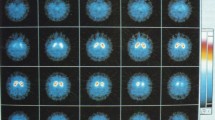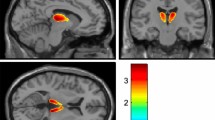Summary.
Parkinson's disease (PD) is characterised by a loss of dopaminergic neurones in the basal ganglia. These neurones may be visualised by single photon emission computed tomography (SPECT) with the cocaine analogue 2β-carboxymethyl-3-β-(4-iodophenyl)tropane ([123I]β-CIT), which labels the dopamine reuptake sites in the nerve terminals. In order to evaluate the possibility to predict the outcome of ECT a prospective study was per-formed with six PD patients in whom the [123I]β-CIT uptake was measured before and after an electroconvulsive therapy (ECT) series. The side-to-side difference in the radiotracer uptake was found to be significantly lower in striatum located contralaterally to the part of the body with the most pronounced symptomathology. No significant change in uptake of the radioligand was seen after ECT. Patients with best uptake and thus with less advanced PD improved most after ECT. The possibility to use the [123I]β-CIT uptake to predict the outcome of ECT treatment has to be further evaluated.
Similar content being viewed by others
Author information
Authors and Affiliations
Additional information
Received February 23, 1999; accepted January 4, 2000
Rights and permissions
About this article
Cite this article
Fall, PA., Ekberg, S., Granérus, AK. et al. ECT in Parkinson's disease – dopamine transporter visualised by [123I]-β-CIT SPECT. J Neural Transm 107, 997–1008 (2000). https://doi.org/10.1007/s007020070048
Issue Date:
DOI: https://doi.org/10.1007/s007020070048




